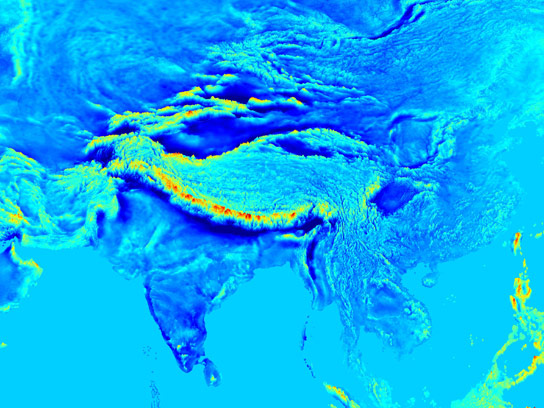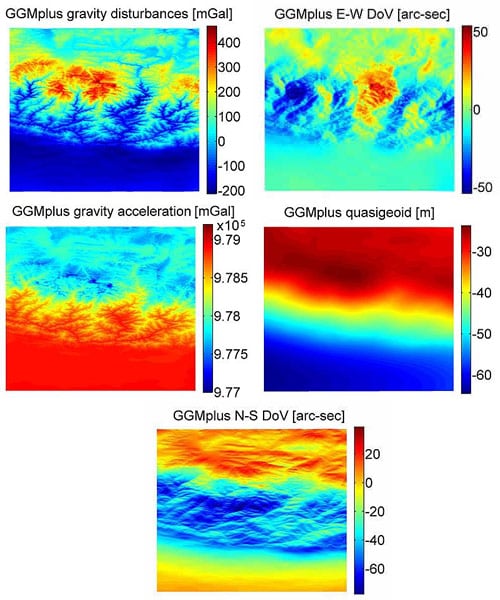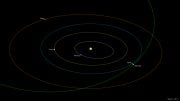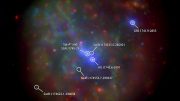
Gravity disturbances over the Himalayas, India, and parts of South-East Asia. Credit: GGMplus Gallery
Scientists from Curtin University and the Technical University Munich have created the highest-resolution maps of Earth’s gravity field to date, revealing gravitational variations up to 40 percent larger than previously thought.
Using detailed topographic information obtained from the US Space Shuttle, a specialist team including Associate Professor Michael Kuhn, Dr. Sten Claessens and Moritz Rexer from Curtin’s Western Australian Center for Geodesy and Professor Roland Pail and Thomas Fecher from Technical University Munich improved the resolution of previous global gravity field maps by a factor of 40.
“This is a world-first effort to portray the gravity field for all countries of our planet with unseen detail”, Dr. Hirt said.
“Our research team calculated free-fall gravity at three billion points – that’s one every 200 meters (656 feet) – to create these highest-resolution gravity maps. They show the subtle changes in gravity over most land areas of Earth.”
GGMplus provides a new ultra-high resolution picture of Earth’s gravity field.
The model has been developed by scientists of Curtin University and Technische Universität München. It is based on satellite-measured (GOCE, GRACE)and terrestrial gravity, and refined with topographic data, GGMplus provides estimates of Earth’s gravity acceleration at about 3 billion points. GGMplus gravity maps are available for all continents with 60 degrees North and South latitude.
The new gravity maps revealed the variations of free-fall gravity over Earth were much bigger than previously thought.
The Earth’s gravitational pull is smallest on the top of the Huascaran mountain in the South American Andes, and largest near the North Pole.
“Only a few years ago, this research would not have been possible,” Dr Hirt said.
“The creation of the maps would have required about 80 years of office PC computation time but advanced supercomputing provided by the Western Australian iVEC facility helped us to complete the maps within a few months.”
High-resolution gravity maps are required in civil engineering, for instance, for building of canals, bridges, and tunnels. The mining industry could also benefit.
“The maps can be used by surveyors and other spatial science professionals to precisely measure topographic heights with satellite systems such as the Global Positioning System (GPS),” Dr Hirt said.
The findings of the research team from Curtin and Technical University Munich have recently appeared in the journal Geophysical Research Letters.
The research has been supported by the Australian Research Council.
Map extracts with continental coverage are available via http://geodesy.curtin.edu.au/research/models/GGMplus/gallery.cfm

The panels show the five GGMplus gravity functionals provided over the Mount Everest area. Credit: Geodesy – GGMplus
Reference: “New ultrahigh-resolution picture of Earth’s gravity field” by Christian Hirt, Sten Claessens, Thomas Fecher, Michael Kuhn, Roland Pail and Moritz Rexer, 12 August 2013, Geophysical Research Letters.
DOI: 10.1002/grl.50838








Interesting presentation, but what is the color code interpretation for the gravity maps? Yellow = high gravity, or low?
A new image has been added to help explain the color code. Thanks-